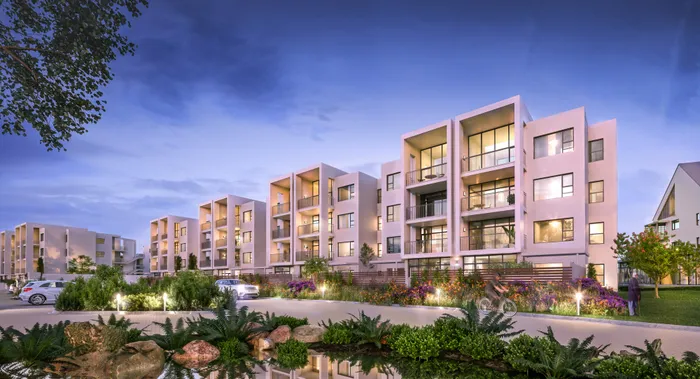
During the six months leading up to August 2024, Balwin Properties, an apartment developer, encountered difficult trading conditions within the residential property market as a result of high interest rates.
Image: Supplied
Is the rapid rise of co-living spaces and micro-apartments in Johannesburg, Cape Town and Durban an innovative urban adaptation, or merely a symptom of the country’s broken economy?
Yael Geffen, CEO of Lew Geffen Sotheby’s International Realty, poses this question.
This is as developers are aggressively repurposing underutilised buildings into shared living hubs where tenants trade private space for affordability and community.
In Cape Town’s Woodstock and Johannesburg’s Braamfontein, companies like The Student Hub and CoLiv report waiting lists for their R6 500 to R8 000 per month rooms that include servicing and WiFi.
Geffen said this is a necessary market correction right now when consumers are drowning in debt, and the vast majority are battling to keep their heads above water.
“For most young professionals, buying a home is an impossible dream at the moment, with the cost of living remaining so high. They’re even being priced out of conventional rentals, but they still need proximity to urban work hubs. Co-living fills that gap intelligently by optimising space and reducing costs through shared amenities,” Geffen said.
Siphamandla Mkhwanazi, a senior economist, recently told this publication that a city like Pretoria occupies a unique position within the broader South African property sector.
He said it benefits its status as the administrative capital, providing stability and a consistent demand for housing.
He added others included a diverse economy, encompassing government, education, and research institutions, relatively more affordable/value for money property options compared to other major cities, attracting a range of buyers and renters and was also seeing a growth in the student rental market, due to the large amount of tertiary education institutions in the city.
Lew Geffen Sotheby’s International Realty said sub-30m² micro-units, never thought of in South Africa’s historically spacious housing market, are now said to be selling out in developments like Cape Town’s 1 on Albert in Woodstock and Sandton’s The Bryant.
Prices start at 20% below standard studios, appealing to singles who prioritise location over square metres.
Geffen said the success of micro-apartments proves that in the current economic climate, affordability trumps size for many buyers.
“But developers must innovate-think modular furniture, premium finishes, and tech integration-to avoid these feeling like glorified hotel rooms."
She says Cape Town’s developments tend to be the most successful in the country at the moment, because the market thrives on scarcity.
“Developers convert heritage buildings into chic spaces, achieving an average of 22% gross margins - nearly double Johannesburg’s conversions.”
Others are new developments like 1 on Albert, offering semi-furnished micro-apartments starting at 21m² that include 24 hour security & CCTV surveillance, biometric access controls, a heated swimming pool, communal recreation area with braai facilities and super-fast internet connectivity. Prices at this state-of-the-art development that is less than 2km from the CBD begin at below R1 million.
Despite the buzz, challenges loom, warned Geffen.
These include investor scepticism as banks remain hesitant to finance micro-developments, seeing them as untested. Cultural resistance as many South Africans still view compact living as a downgrade and oversupply risks as Durban’s Umhlanga corridor already shows signs of co-living saturation.
“The danger is that we mistake a stopgap solution for a cure. Co-living can’t replace the need for broader housing reform, including faster planning approvals and incentives for mid-income developments.”
Geffen said industry leaders are split on whether this trend will last. While some predict co-living will grow to 15% of South Africa’s urban rental market by 2030, others argue it is merely delaying a reckoning with unaffordability.
“The real test is whether these models can evolve beyond student and young professional niches to serve families and older demographics. That’s when we’ll know if this is truly transformative or just a Band-Aid,” added Geffen
Geffen noted key market questions going forward include whether local government entities will relax density restrictions in a greater number of suburbs to enable more micro developments, whether these developments will be the turning point for inner city decay and whether more relaxed density zoning in wider areas will make it more affordable for buyers to get onto the property ladder.
“South Africa’s housing crisis won’t be solved by one solution alone.
“This trend isn’t a total fix, but for now, co-living and micro-apartments are to some extent rewriting the rules of urban residential design and offering a solution to younger professionals struggling to make ends meet with the immensely high cost of living in the country’s stagnant economy,” Geffen said.
Today’s savvy buyers are said to be embracing starter homes like one or two bedrooms, a single bathroom, and enough room to live well without the stress of major upkeep.
According to Jonathan Spencer from OneDayOnly.co.za, these homes typically range from 70m² to 116m², offering the perfect blend of comfort, affordability and personal style potential.
“Starter homes are the ideal launchpad for new homeowners. They tick all the essential boxes without overwhelming you financially. Plus, there’s more room in your budget to create a space that really feels like you,” Spencer said.
Related Topics:
